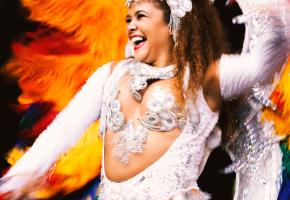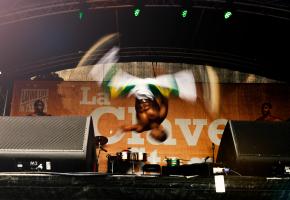Largely brought up in a matriarchal family, surrounded by mother, sisters and grandmother, Feliciano Centurión(1962-1996) developed an early interest in the crafts, lacemaking, crochet and other handiworks being carried out by the women around him. Attempts to deflect him from these ‘feminine’ artisanal pursuits failed dismally, to our delight, as today we can enjoy his unusual tapestry-style ‘blankets’ with embroidered and patch-worked designs and poetic, heartfelt messages. Being encouraged not to play with dolls, he then chose to dress other types of creatures with his hand- made creations.
During his early years, Paraguay was under the right-wing dictatorship of Alfredo Stroessner. His family was forced from their home in the tiny village to Alberdi, into exile in Argentina in 1973. Being ‘a gay man in an ultra-conservative society’, he decided to move to Buenos Aires in the 1980s. Thanks to his association with the Ricardo Rojas Cultural Centre, under the tutorship of Jorge Gumier Maier between 1989 and 1996, he became a key member of a group of artists that were challenging the status quo, in favour of a more subjective and layered approach. At that time, as Argentina itself was trying to recover and process the pain and suffering it had endured after years under the Military Junta Dictatorship, Art tended to be very political and engrossed with Human Rights issues. This group chose to be more progressive and challenging, exploring the ‘beauty’ in everyday items, found objects, even pillowcases and blankets, “opening a new way of understanding the subjectivity of being human”.
After their first important exhibition in 1992, a critic, Jorge López Anaya labelled them “Arte Light”, despite the derogatory nature of this title, the name stuck. They were not bothered by it and used it themselves. Their aim was to find the beauty in the unexpected, they even explored the complexities of kitsch and consumer items. Interestingly, Centurión’s embroidered narratives echo works of ‘Brit Art’ artists like Tracey Emin, who were at the same time, also exploring mundane and everyday items, exploring contexts in which they appear both beautiful and moving.
This exhibition brings together a selection of his smaller pieces that he developed after he had been diagnosed with AIDS. Many are being shown publicly for the first time since his death. Evoking his early life surrounded by nature, birds, animals and water; he used these memories to create images, appliqué, embroideries and patterns, interlaced with embroidered phrases and messages that reflected his emotions as he faced the end of his short life. Some of his larger works, his ‘blankets’, were hung at the 33rd São Paulo Biennale in 2018.
 São Paulo Biennale
São Paulo Biennale
Paraguay has had a tumultuous history. From 1864- 1870, it was involved in the Paraguayan War, or the War of the Triple Alliance, with Brazil, Uruguay and Argentina. Paraguay suffered terribly, losing most of its male population. This gender imbalance was not helped by Alfredo Stroessner’s Military Dictatorship (1954- 1989), as he ruthlessly persecuted his opponents, actively participating in ‘Operation Condor’. This was a clandestine campaign coordinated by several South American hard-line rulers which led to people being brutally tortured and ‘disappeared’ as per the rules of the ‘Panama School’ run by the CIA.
According to some, this contributed to the ‘matriarchal’ society in Paraguay that grew out of this turmoil and the ‘lack of men’. Centurión used & developed the skills the women passed down to him to his best advantage. Some more traditional critics and artists have seen this ‘Arte Light’ of the late 1980s and 1990s, as a ‘great cultural enemy’, but it has its value, as it challenges the rigidity of the status quo, bringing new outlooks and perspectives to the medium. There is a freshness of creativity that is whimsical, delightful and also very poignant, given his early death. There is a feminine visual language as he explores gender and sexuality in his work. Slowly but definitively, his work is gaining recognition, with his works being found in important collections such as the Solomon R. Guggenheim Museum in New York, The Blanton Museum of Art in Austin, Texas. Madrid’s Reina Sofia Museum has work by Centurión as part of a donation from the collector Patricia Phelps de Cisneros. Other collections include the Latin American Art Museum (MALBA), Buenos Aires, The Museo Nacional de Bellas Artes (MNBA), Buenos Aires, The Amalia Lacroze de Fortabat Art Collection, Buenos Aires, Clarice Oliveira Tavares in New York City, and Don Mullins, Austin, Texas, amongst others.
Mon Ross' has filmed a documentary film revealing an intimate portrait of Centurión's life and works through the memories of his Paraguayan and Argentine friends (find the trailer below in Spanish):
Cecilia Brunson Projects represents the Feliciano Centurión’s estate, and Cecilia Brunson chose to exhibit his work as she is acutely aware that there is a notable lack of a Paraguayan presence in the Latin American Art world. On the evening of the opening of the Centurión exhibition, Brunson explained the philosophy behind her gallery: -
“Five years ago I realized that many Latin American artists were being ‘plucked’ from Brazil… Chile, or Argentina and were working with important galleries like The White Cube or Thomas Dane, but in this way, they were taken out of context. They were in a more international arena, but I felt the need to open a space that worked closer with the idea of context: what is it about the differences between the countries… and the artists? Brazil and Mexico, for example, are completely different cultures. What is the significance of this region that shares a common tongue… some common customs… even colonialism [religion?] so, I decided to open a gallery exclusively dedicated to Latin American Art.”
“ When Feliciano arrived in Buenos Aires he realized that he had lived in a universe of alligators and flamingos, having had to take a small boat down the river every day to get to school… it reminded me of that film “ The Mission” with Jeremy Irons… he was brought up in a humble place, living very close to nature, so when he found himself in the ‘urban’ city of Buenos Aires, he realized how much nature was a vital part of who he was and he integrated it into his daily activities.”

Cecilia Brunson was born in Santiago de Chile, but she studied and developed her career in New York, working for the American Society, that is one of the David Rockefeller Foundations dedicated exclusively to Latin American Art at a museum called the Blanton Museum of Art. This background was vital to her decision to develop a space in London for the same purpose.
Brunson was very moved when she went to meet the family of Feliciano Centurión in Paraguay: -
“When I went to see the work, I was presented with a box, and they told me that before he died, Feliciano had organized all his smaller ‘blankets’ in that box and told them not to open it until the right moment. When finally, the box was opened many years later, the first work on the top read “I am alive”! And in this way, the trajectory of his posthumous works started. In this exhibition, I chose to put that very blanket right next to another that has rows of ‘skirts’ which speaks of the matriarchal, feminine household in which he grew up, rightly evoking a sensation of what his work and his life were about.”

I am Alive. c1994 Embroidery with inclusion on blanket 46 x 51 cm Photo Eva Herzog
FELICIANO CENTURIÓN (1962-1996) “I AM AWAKE” (works from 1992-1996) September 19th – December 13th 2019
CECILIA BRUNSON GALLERY
2G Royal Oak Yard
Bermondsey Street
London SE1 3GD
OPENING HOURS
Tuesday to Friday, 10am – 6pm
Weekends/out of hours - by appointment
Closed between exhibitions and public holidays



















